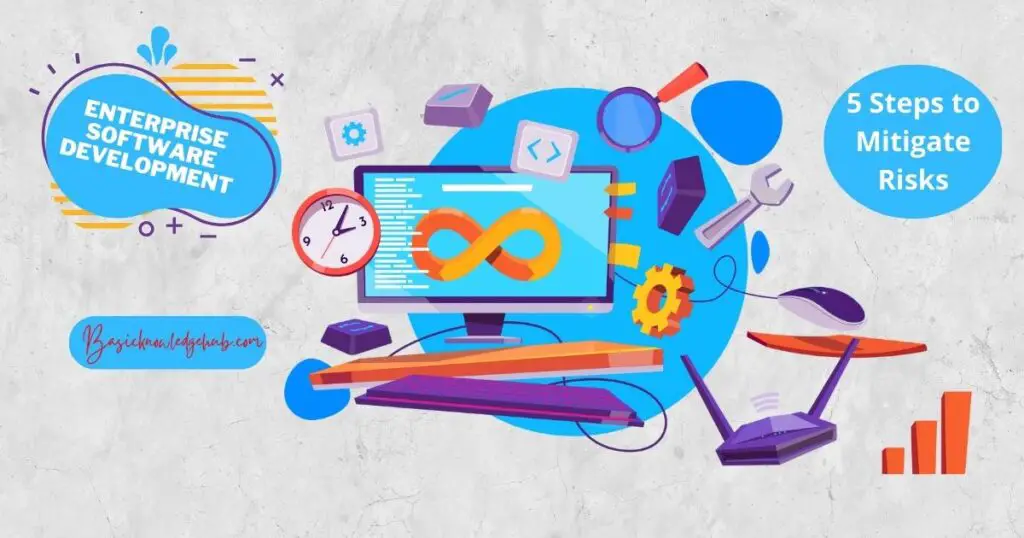5 Steps to Mitigate Risks in Enterprise Software Development
Enterprise software Development is a specific field of Software development. Their main purpose is to develop or create a particular software system for business. This software was used by big organizations, and they also support large enterprise operations with the help of the software. But have you ever thought that there could be so much risk involved in it? This software can be hacked by a hacker or different threats may also be possible. The software can even malfunction and may the data be leaked. According to some reports on the internet about some of the most common Mitigate Risks in Enterprise Software Development.
Risks are in everything, even software Development involves risks Such as Lack of communication, Scope Variations, Poor Code quality, Client-User agreement, Less Productivity, Laziness towards work, Not giving work on deadline, Incorrect use of technology, and even more will discuss below, this risk is very important to overcome because it will create a long impact on your work or on your company. We will provide some solutions to resolve this issue. Due to the risk involved in it, several projects fail every year, and the company loses Crores of rupee due to this.

What is Enterprise Software Development?
Enterprise Software Development involves developing code, designing, testing, and maintaining. However, The Software is made to solve a problem in order to automate a particular thing. There is usually an organization that makes software and sells that to a particular client. Software is made by programming languages and backend technology. A team of professionals led the project and made the software. Enterprise solutions also use some the tools like databases, frameworks, project management, etc and with the help of these tools, they built a particular software.
Although the software may be flawed due to some risks which are involved in it. So will find out the risk and will give you the solution to it. A few steps are involved in solving the risk like analyzing the problem making a risk management plan, and deploying the project in the work. By this, we can Mitigate risks in Enterprise Software Development. Let’s start with the risk and their solution in this article.
Lack of Communication
Communication is one of the best ways to impress or de-impress clients. The way you communicate is one of the major risks involved in Software development. If your company or a client has said something or you have something else then it will definitely destroy your project and your hard work. The client or a company has told you to write a specific code for software but you haven’t listened properly and then you end up losing the project.
Solution:
- Communicate properly with the development team, client, or the company
- Make a proper work plan and then execute the work
- Even ask the client about their requirement so it will help you to avoid this issue.
Scope Variation
Scope variation refers to an uncontrolled expansion of the project scope. Generally, this happens when a project requirement or deliverables are not clearly defined. Even have added some additional functions or features without proper documentation or approval from the company head or a client. Scope variation will impact the project deadlines, budget, project failure, or even many more things.
Solution:
- Be assured that the project is well-structured and well-defined. This will help you to build the project on time and it will definitely avoid misunderstanding.
- Be assured that the scope of the project should be defined properly and tell your team to give suggestions to achieve it.
- Also, do research on finding the best solution and apply it properly.
Poor Code Quality
Software is made using coding languages and there are many languages available for
programming the software. The coding quality is the topmost important, the code will help the software to look good. Poor quality code is code that is difficult to read, and also difficult for other developers to review. Even the developer hasn’t tested the software before publishing. Programmer’s team combined to make the software. The Quality of coding should be improved to give good-quality work.
Solution:
- Improve the quality of the code
- Test your code before delivering it to the company or client.
- Review the code
- Always tell your team to look into the detailed code for any errors.
Less Productive
Productiveness is another aspect to mitigate risk in software development. A fully planned structure can help you to develop a good product. Less productiveness will take more time to develop the software. A leader must help his team to be more productive. Less productive work tends to be time-consuming, low interest, client dissatisfaction, etc.
Solution:
- Be More Productive towards his work
- Set a plan for the project and be productive on it.
- Involve in engaging activity to be more productive throughout the day
Calculated Risk Management
Risk Management is in everything, and a calculated risk is a good way to avoid huge risks in software development. A proper risk is a good way to insure risk-free things. Software development involves risk but if we calculate that risk then we can avoid huge risks in it. A proper format for making software and doing everything on time may help you in your work properly. Many strategies out there to help you with this issue. Let’s discuss some of the solutions to help you overcome this situation.
Solution:
- Make a plan for every work that you do
- Define some risk for each plan
- Manage work in a structured way
By this, you can manage everything at low risk.
Conclusion
To Mitigate risk in enterprise software development it is very important to find project success. Risks such as changing requirements, technical difficulties, poor project management, and resources will have so much of an impact on project timelines, budgets, and other outcomes. The risk has its own advantages and disadvantages. So, Identifying the risks and then analyzing them and it’s impact on the project. However, again implementing proper risk management measures to mitigate the impact is a part of effective risk management strategies. So, by Establishing a good management strategy and applying it through testing and quality assurance activities, engaging experienced software developers with necessary technical expertise, and deploying a robust project management process.
It is very very necessary to keep in mind that mitigating risk in enterprise software development is the process that will be monitoring, assessing, and modification of risk management strategies. Software developers and their teams can successfully deliver a high-quality software product that meets the needs of a company or a client by putting effective risk management strategies into it. By doing so, they can decrease the likelihood and impact of potential risks.
Communication is also an important aspect of effective risk management. Risk management plans must be communicated to project stakeholders, and regular updates on the status of risks and the progress of risk management activities must be provided. Effective communication can help to maintain trust and confidence among stakeholders, and it will also ensure that the project necessities are met. All these things are very important to be considered in the risk part and I hope that this article has helped you to know about how to Mitigate risks in Enterprise Software Development.
FAQ
1. What type of strategies can the software development team use to mitigate technical risks?
Risks can be lower by performing certain tasks like testing, quality assurance activities, utilizing appropriate development techniques, and instruments, and enlisting experienced software developers having some relevant technical skills.
2. How can a project manager effectively communicate risk management plans with the stakeholder?
By making continuous notifications regarding the state of risks and the progress of risk mitigation activities, project managers can effectively communicate risk management plans to project stakeholders. They may additionally employ visual aids to convey the level of severity and probability of each risk, such as risk heat maps and charts.
3. How do you identify and analyze potential risks in enterprise software development?
Teams of software developers can do an in-depth review of project requirements and actively engage stakeholders to identify and analyze potential risks. They can then assess the likelihood and impact of each risk and rank them in order of severity.
4. How can project managers effectively manage changing requirements in enterprise software development?
To successfully manage changing requirements, project leaders should implement a straightforward change in the management process that includes documenting changes, assessing their effect on the project’s timeline, budget, and resources, as well as obtaining approval before implementing changes.


